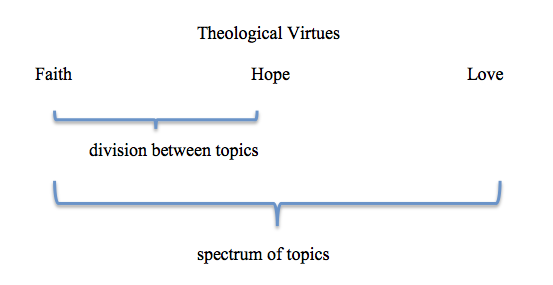Overview
This structure locates a topic (e.g., hope) within a larger general category (e.g., theological virtues) and then examines that topic by comparing and contrasting it with other topics (e.g., faith and love) that fall under that category and are similar to but different from the topic at hand. The general category serves to unify the system of topics that appear in the sermon and the work of classification highlights the reasoning that helps hearers separate the topic at hand from the others that are similar to but different from it.

In composing the sermon, the preacher needs to be aware of whether the spectrum of topics is all-inclusive (e.g., three persons of the Trinity) or suggestive (e.g., four types of prayer) and whether the division between topics is absolute (e.g., converted or not converted) or approximate (e.g., practical theology and systematic theology).
Classification is useful for helping hearers understand a topic within a larger frame of reference. The preacher normally chooses the larger frame of reference in light of the hearers and possible misunderstandings within their context. For example, a preacher could consider the Lutheran understanding of eschatology within the larger frame of reference of other Christian interpretations of the end times or a preacher could consider the Lutheran understanding of eschatology within the even larger frame of reference of other faith traditions or the even larger frame of reference of secular worldviews. Depending upon what challenges are confronting one’s hearers, they will understand their belief about eschatology in light of other Christian traditions, in light of other faith traditions, or in light of various cultural views of the end of the world.
Classification is often confused with definition. Definition is like placing a topic underneath a microscope examining its parts; classification is like taking that topic out from under a microscope and looking at it in relation to other similar but different topics in the world. So, for example, one could define the Lutheran practice of the Lord’s Supper. In contrast to definition, classification expands the vision of the hearers beyond the specific topic and considers that topic in relationship to other topics (Reformed practice of the Lord’s Supper and Roman Catholic practice of the Lord’s Supper) that fall under a larger classification (Eucharistic Practices). The hearers will understand the topic (Lutheran practice of the Lord’s Supper) not by an enumeration of its parts (as in definition) but by a consideration of how it is similar to but different from other Eucharistic practices.
Example
Chapel Sermon by Leopoldo Sanchez from Ephesians 4:1-6 on Wednesday, June 9, 2021:
